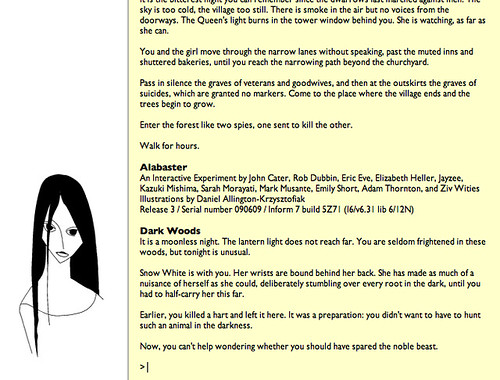Posts with ‘EmilyShort’ Tag
Alabaster
By: Derek Yu
On: June 16th, 2009
Alabaster is a new interactive fiction game from Emily Short and various other authors that takes place in the world of Snow White. In the game you’ve been asked by the Queen to execute Snow White in the woods and bring back her heart in a box. Snow White, however, has another plan. Now that you’re out in the woods and alone with Snow White, which of the two women do you trust?
There’s a lot in this game to be interested in, starting with the game’s dark fairy tale setting and the themes that the game touches upon throughout the course of your conversation with Snow White. Secondly, there is the conversation system itself – it’s designed by Short, who laid out some of the concepts behind the system in her article about conversation in games. Alabaster also utilizes simple procedural illustration to lend a little more depth to the story without showing up the player’s imagination.
Finally, the creation of the game was rather unique in and of itself – although Emily Short wrote the introduction of the game, the conversation pieces, or “quips” were written by numerous contributors (John Cater, Rob Dubbin, Eric Eve, Elizabeth Heller, Jayzee, Kazuki Mishima, Sarah Morayati, Mark Musante, Adam Thornton, and Ziv Wities) and then tied together stylistically at the end of the development. The result is 18 different endings and over 400 quips, many of which have alternate versions, depending on the situation. The entire conversation tree is available for download, along with the game’s source code.
But is the game a success? Well, my early impressions of the game is very favorable. The story and writing are, naturally, very good. I love the idea of unraveling characters through conversation and the way you must use this information to ultimately make a decision to trust one person or another. Short’s conversation system is adequately complex, too, although the recurring problem in IF games – namely, how do I phrase what I want to say so that the interpreter understands it – is there. Conversational hints and the “CHANGE THE SUBJECT” action are very useful, but I’m still slightly resentful of them (they can be turned up or down). Still, this system is a step forward from the other (admittedly few) IF games I’ve played, and the story is well-worth following through.
TIGdb: Entry for Alabaster
Emily Short: Conversation Methodologies
By: Derek Yu
On: May 14th, 2009

Interactive fiction writer and pioneer Emily Short has a regular column at GameSetWatch called “Homer in Silicon.” In her latest column, titled “Sub-Façade,” she describes some ways to approach conversation modeling in games. The name comes from the game Façade.
Conversation is such an important part of real life, and yet in games it doesn’t seem like it’s discussed very much (at least outside of the IF community). It’s not too surprising – real conversation is an extremely complex and nuanced form of communication that is affected by all kinds of internal and external stimuli. In most games, it’s not only unnecessary to have realistic communication, but also extremely time-consuming to implement (indeed, since you would be essentially inventing the wheel), and probably a hindrance to the player as well.
That said, games are the perfect place to explore conversation (or anything, really). And who better to open up the discussion to the general public than Ms. Short, who has authored many award-winning interactive fiction games that focus on conversation. I thought this was a fascinating article that earns bonus points for containing the phrase “atomic quip.”
Interactive Fiction Cover Art Drive
By: Terry
On: April 26th, 2008
| For the last two months or so, Interactive Fiction veteran Emily Short has been running a cover art drive. The basic idea is that attaching something visual, like a cover, to various works of Interactive Fiction would make it easier for sites (like ours, I guess) to promote the brilliant and very overlooked interactive fiction scene to a wider audience. It’s gone pretty well – including alternates, there are currently 98 submitted covers in the photostream (some examples are included in the side image), but there are still quite a few games outstanding.
I know there are officially only a few days left, but after seeing all the artistic talent on display in tonight’s iScribble session I figured that there are probably quite a few people reading this that could help out with a final push! To take part, all you have to do is create a cover like the ones on the side for any interactive fiction game and send it to Emily. A good place to start would be this post on her blog which lists a few games which have requested cover art but haven’t gotten any yet. Even if you’re not familiar with those games (or any interactive fiction), I’m sure someone on the forums would be more than happy to give you a synopsis or describe a scene. Full details about the project (including detailed clarifications) are collected here. As of right now, here are the games still looking for cover art:
There are officially only three days left, so if you’re interested, get cracking! |
 |
Word Play
By: Terry
On: October 19th, 2007
Veteran game reviewer Kieron Gillen (who’s previously written for PC Gamer, EDGE and Eurogamer, among others) has reposted an old EDGE article to his collaborative games blog, Rock Paper Shotgun. The article is entitled “”http://www.rockpapershotgun.com/?p=440">Word Play", and it’s about the use of text in videogames.
The first half of the article is compelling enough, I suppose, but it’s the second part that’s really interesting to me. Kieron moves on to discuss “one corner of the modern games scene [where text] is dominant… the Interactive Fiction or IF Community. Or, as they were known in the eighties, text adventures.”

This section includes interviews with IF notables Emily Short and Adam Cadre (the authors of Galatea and Photopia, respectively), and talks about their influences, their approach to game design, and their view of how things are going to pan out for IF in the future.
I remember reading it in EDGE a few years ago, and at the time, I’d only played Photopia and some older well known text adventures like Zork and Colossal Cave. This article is what finally got me to explore Interactive Fiction in more depth, and I’m quite glad I did! There seemed to be something missing from this republished version though, so I dusted off my collection of old copies of EDGE and had a look for the original article (it’s November 2004, E142). Huzzah! The original had a little separate boxed off section titled “A short IF reading list”, which listed a number of introductory titles that I recommend checking out as soon as you possibly can, if you haven’t already.
I don’t know why this wasn’t included in this version of the article, but it’s well worth reading, so I’ve copied it from the original and reproduced it here. Hit the extended to read it!
A short IF reading list [from EDGE 142, November 2004]
With hundreds of games available, it’s difficult to know where to start with IF. In an attempt to avoid such difficulties, these are a handful of relatively accessible base camps to start your explorations.
PHOTOPIA (ADAM CADRE)
A fractured narrative piece that takes its time to unwind, juxtaposing real-world encounters with a dreamy fantasy story. When it hits its emotional target, it takes off the top of your head.
SHADE (ANDREW PLOTKIN)
Kitchen-sink realism transforms into unresolved, lingering and disturbing psychodrama. Also consider the longer, puzzle-based Spider and Web, based around flashbacks from an interrogation.
GALATEA (EMILY SHORT)
A conversation between an art critic (the player) and a living statue (the single, highly developed NPC). With dozens of endings, this is unique and literate. Consider also Short’s later, relatively short romances Pytho’s Mask and Best of Three.
SHRAPNEL (ADAM CADRE)
More of a fragment, in every definition of the word, than a fully developed piece, this is still a memorable and brutally powerful work.
RAMESES (STEPHEN BOND)
Minimal in terms of player action, this uses forced inaction as a metaphor for teenage depression.
All games are available from the IF Archive. Links and reviews are available from Baf’s IF Guide. Most games will require a Z-Code interpreter to play, also available from the above. We recommend WinFrotz for Windows, but MacOS, Linux and PocketPC versions, among others, are also available.


